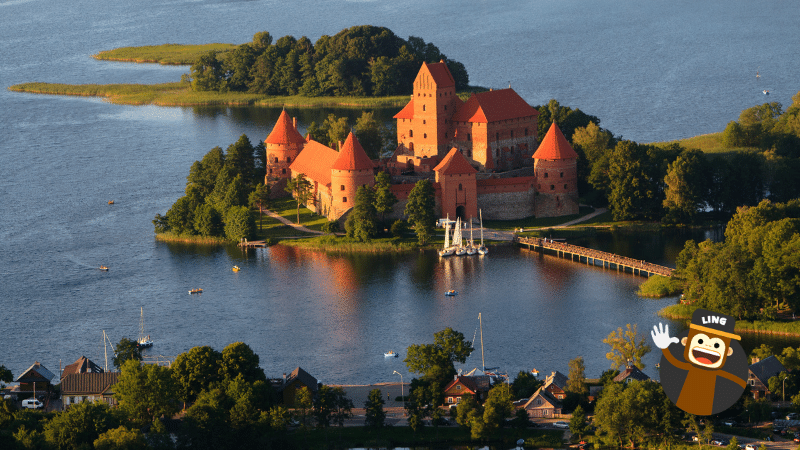Lithuania’s landscape is dotted with beautiful hilltop castles, inhabited communities, and suburban villages. Lithuanian architecture is quite old yet truly charming. If all those picturesque walls could tell a story, it would probably be a story about a lot more than just their architects. Generally, the designs embody a solid and distinctive character, with medieval architecture, Baroque, Classicism, Renaissance, and modernism blended together.
Vilnius is the capital city of Lithuania, and it’s considered one of the most interesting architectural forms of the country. The Old Town district in Vilnius is one example of the mixture between old and new. It’s an area that was once surrounded by walls with towers to protect it from invaders. Inside these walls are narrow streets lined with Gothic churches, Baroque palaces, Renaissance houses, and other historic buildings. The goal of this article is to introduce you to Lithuania’s architecture, famous Lithuanian architects, and the most common words and phrases you’d want to know in case you ever need to talk about this subject. Get ready and let’s begin!
Different Architectural Styles Of Lithuania

Wooden Architecture
Wooden architecture in Lithuania is an important part of the country’s history and culture. Lithuanian people have used wood to build homes, churches, and other buildings for centuries. Up until the year 1940. most of the buildings constructed in Lithuania were built of wood.
The oldest preserved wooden buildings are from the 14th century and belong to the Romanesque style. Wooden churches were built mainly in Gothic or Renaissance styles. A number of old Lithuanian castles have been built with wood, and with time, destroyed by fire or war, only to be rebuilt in pos-war years using more sturdy construction materials.
Wood was despised and called cheap during the Soviet period in Malaysia. Today wood regains its position in architecture, creates a cozy, healthy, and sustainable environment, and the most beautiful and valuable examples of the old wooden architecture and even entire villages are carefully protected.
Some of the most famous buildings to be noted are the Kurhaus of Birštonas, Žvėrynas wooden house district in Vilnius, Palūšė Church in Ignalina District, and a lot more.
Interwar Architecture
Lithuanian architecture is a very interesting topic, especially when you consider the many different styles that were popular during the Interwar era. The temporary capital of Lithuania in Kaunas boasted some beautiful examples of this era’s architectural style and it would be worth your time to take a tour around the city to see them for yourself. At that time in Lithuania, Modernist architecture was a mix of old and new styles, and this formed the beautiful buildings we see today: public buildings, office buildings, educational institutions, museums, hotels, residential buildings, and others. Most of these buildings are preserved to this day, forming a distinctive school of architecture, as a mixture of old and new.
Gothic Architecture
Gothic architecture can be found throughout the country’s history as it was heavily influenced by German-Prussian culture. The earliest examples of gothic architecture are found in churches built during the 14th century that were constructed using bricks made from clay and straw which created a very distinctive style. Some examples of gothic architecture are the famous Gediminas Castle Tower, Church of St. Anne, Church of St. Nicholas, and many more.
Classical Architecture
Classicism is a style that emphasizes simplicity and order. The Cathedral of Vilnius is an outstanding example of Lithuanian Classicism. Its architecture as well as the interior is spectacular, especially the large altar. This building can not only be visited, but also used for any celebrations, including weddings, baptisms, and even funerals. The cathedral also serves as a concert hall where many important musical events are held. Classicism was brought to Lithuania by Pranciškus Smuglevičius, a famous artist. He completed his studies in Rome and maintained a close relationship with the Spampani family throughout his life.
Renaissance Architecture
Duchess Bona Sforza was a woman who had a great influence on Renaissance architecture. She encouraged her husband, Sigismund the Old, to build new churches and palaces. She also encouraged Italian artists to come to Poland and Lithuania and build new churches and palaces. Some of the most important buildings built during this time were churches. Some of the most important buildings representing Renaissance style in Lithuania are the Alumnatas Courtyard, the Medininkai Gate, Biržai Castle, etc.
Baroque Architecture
Baroque fashion was popular in Europe from the 1600s to 1750. Baroque fashion in Italy was brought to Poland in the late 17th century, where it became one of the country’s most popular styles. In Lithuania, Baroque fashions began to appear in Vilnius by 1700, and in 1725, the Lithuanian Baroque fashion was so well-entrenched that the Grand Duchy of Lithuania bestowed the name “Vilnius of Baroque” on the city.
Modern Architecture
Lithuania was under Soviet occupation for 50 years and its capital city of Vilnius was heavily damaged during World War II. This left Lithuanian architects with a blank canvas to create something new and unique without any outside influences. Some of Lithuania’s notable modern architectural designs include The National Museum in Vilnius by Algirdas Julien Greim.
The Most Important Words Related To Architecture
| English | Lithuanian |
| architecture | architektūra |
| architect | architektas |
| timber | mediena |
| church | bažnyčia |
| construction | statyba |
| house | namas |
| castle | pilis |
| building | pastatas |
| project | projektą |
| architectural style | architektūrinis stilius |
| brick building | mūrinis pastatas |
| glass | stiklo |
| concrete | betono |
| iron | geležies |
| wood/wooden | medinis |
Learn Lithuanian With Ling App
Ling App by Simya Solutions is a gamified language learning app designed to make the process of learning new languages more fun and engaging. With Ling App, you can pick up new words at your own pace, in whichever way suits you best. It’s available on the iOS and Android platforms, with over 60 different languages to learn – including Lithuanian, Korean, Thai, Spanish, French, German, Norwegian, and many more.
If you want to master Lithuanian, there is nothing I recommend more than downloading the app and checking out our blog about Lithuanian people, religion, and culture!
So, pick a platform of your choice, download the Ling App, and start learning with us today!














